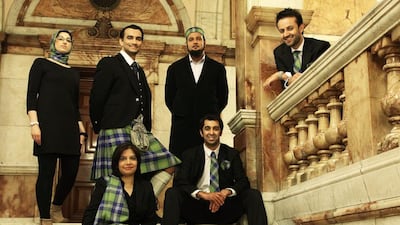Twitter and Instagram users may have noticed a post in the past few days, announcing that Scotland has created a tartan for its Muslim citizens.
The majority of the interest comes following a Tweet by Canadian human rights activist Laura Morlock. In her post, she outlines the details of the tartan and what they signify.
While the post has rejuvenated interest in the tartan, it is not a new thing. In fact, the tartan was announced in 2012, designed Azeem Ibrahim, milled by DC Dalgliesh and registered as the "Scottish Islamic" tartan on the Scottish Register of Tartans.
On its website, it explains the design, writing, "The theological explanation of the design is as follows: blue represents the Scottish Flag; green represents the colour of Islam; five white lines running through the pattern represent the five pillars of Islam; six gold lines represent the six articles of faith; the black square represents the Holy Kaaba."
It also says, "The Scottish Islamic Tartan weaves together the different strands of Scottish and Muslim heritage creating a fabric for the future."
The tartan was developed in collaboration with leading Islamic scholars around the world.
At the time of the 2012 release, Ibrahim wrote a Huff Post think piece about the significance of the tartan. He also featured in the shoot, modelling the new tartan in 2012.
"The flag of St Andrew’s cross or the Saltire is as familiar in immigrant communities in Scotland as the crescent of Islam, with allegiance to both being a powerful component of citizenship," Ibrahim wrote. "As a Scottish Muslim, I am deeply involved in the dynamics of community and the exploration of values of national and ethnic pride.
"With the design and introduction of a Muslim tartan, I hope to interest, challenge and provoke discussion among people who have Scotland’s interests at heart ... What more fitting symbol of this aspiration than an Islamic Tartan?" he added.
Reaction to the Islamic tartan
As with everything on the internet, there has been pockets of backlash, but by and large the reaction to the interest in the tartan has been positive. It's been described by Twitter users as a "powerful symbol of recognition" and "inclusive".
Humza Yousaf, who appeared in the original shoot with Ibrahim and is now Scotland's Justice Minister, reacted to Morlock's tweet, writing, "Oh man, this was around seven years ago, modelling (and I use that word [very] loosely) the Scottish Islamic tartan. An importantly symbolic initiative that brought together the various strands of our multifaceted identities as Scots, Muslims etc."
Another Scot used the opportunity to muse their own family tartan on Instagram.
"I am really inspired by Scotland’s official Muslim tartan ... Tartans historically have been used as identification and to show belonging, either as part of a family, a clan, or a specific region," Heather Bamford wrote on Instagram, with a photo of her own tartan, for Clan Greer.
"The meaning behind the Muslim tartan shows understanding of and appreciation for faith and culture. By creating an official #Muslim tartan, Scotland is saying, 'You are welcome here.' This is beautiful. This is inclusion."



